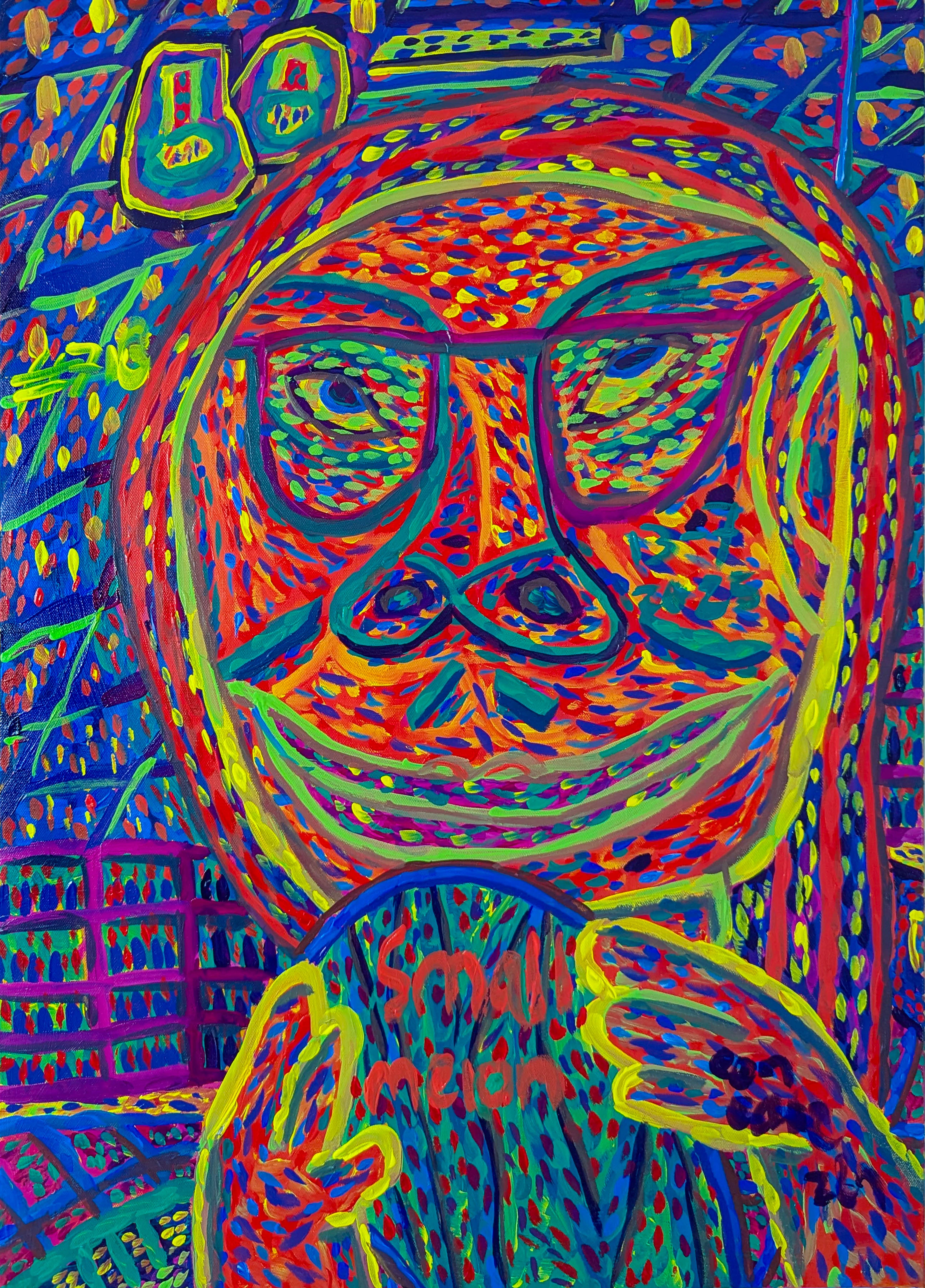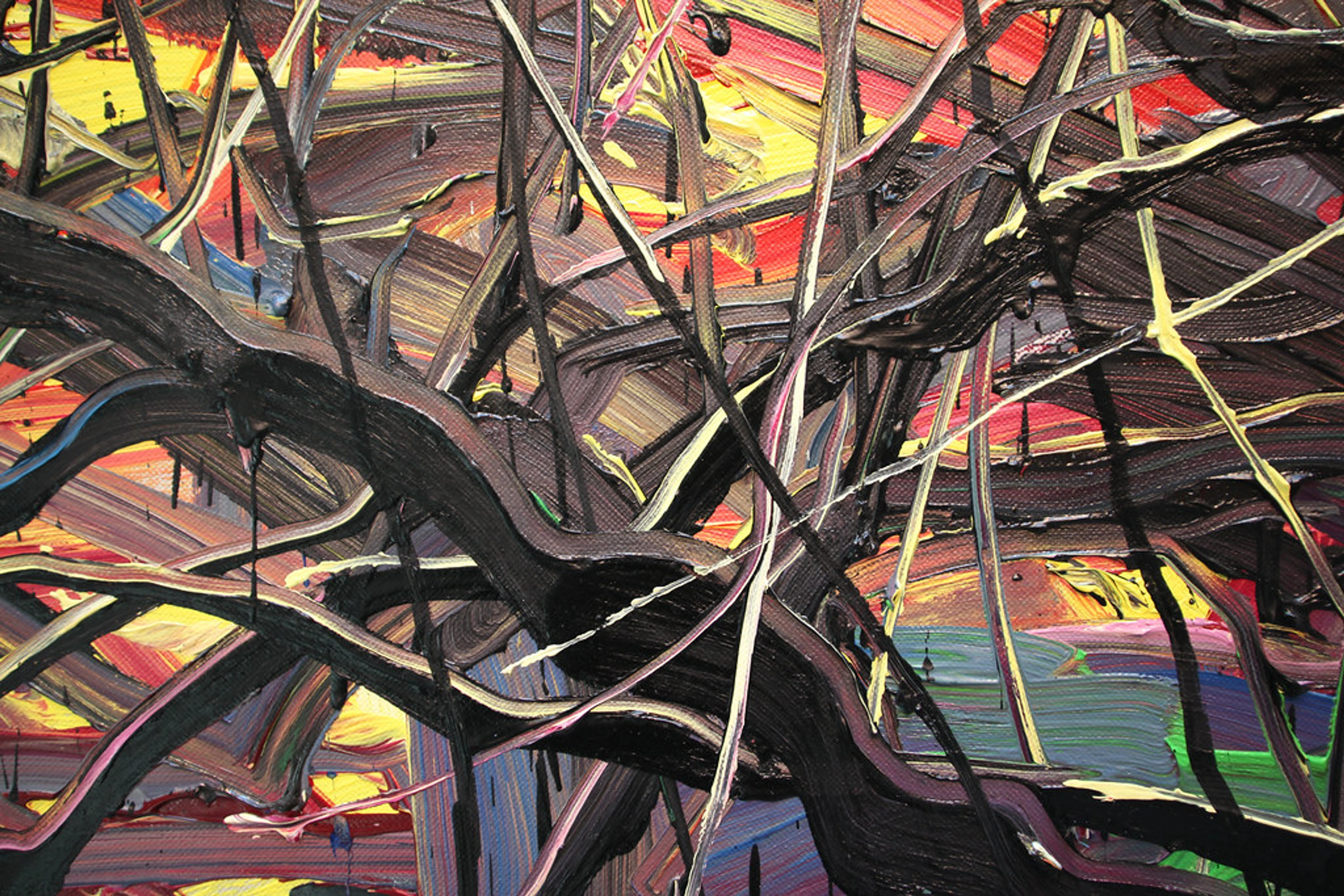
Zeng Fanzhi: An Introspective Guide to Art, Identity & Evolution
Uncover the profound journey of Zeng Fanzhi: from raw Hospital Series to the unsettling Mask series and chaotic Abstract Landscapes. Explore his evolution through painting, sculpture, and multimedia, delving into identity, social change, and the universal human condition.
Zeng Fanzhi: An Introspective Guide to the Man Behind the Masks (and Landscapes)
Okay, let's talk about Zeng Fanzhi. You might have seen one of his Mask paintings – those unnerving figures with fixed smiles and oversized hands – or maybe heard about the eye-watering price tag on his version of The Last Supper. (Honestly, who doesn't dream of stumbling upon a forgotten masterpiece worth millions, even if only in their wildest art-market fantasies? It's like finding a winning lottery ticket in an old jacket, only the jacket is a dusty attic and the ticket is a canvas). Or perhaps you're just curious about this giant of Chinese contemporary art in China. Honestly, diving into the work of a major artist can feel a bit like trying to assemble flat-pack furniture without instructions – confusing, maybe a little intimidating, but potentially rewarding if you stick with it. Why does his art, especially the Mask series, resonate so deeply, even if we can't quite articulate it at first glance?
I find his journey fascinating, not just because the art itself is powerful, but because it mirrors the seismic shifts in China over the last few decades. It’s like watching a personal diary unfold against a backdrop of massive historical change, something that resonates even if your own context is wildly different – perhaps like trying to capture your own personal timeline through art. I remember feeling a similar unsettling thrill, or maybe a dizzying sense of possibility mixed with unease, when I first stepped into a rapidly transforming city; it’s that sense of the ground shifting beneath your feet, of old certainties fading and new, unpredictable realities rushing in. His work grabs you, sometimes uncomfortably, and makes you think. But before we get lost in the canvases, maybe we should ask ourselves: who is this guy, really? Let's rewind a bit, shall we? Because understanding the artist often means understanding the journey.
Who Is Zeng Fanzhi, Really?
Born in Wuhan, China, in 1964, Zeng Fanzhi came of age during a period of immense social and economic transformation. Imagine growing up in a place on the cusp of dizzying change, where the old ways are still whispering, but the future is screaming. That's Wuhan in the 60s and 70s, and you can bet it left an imprint. He studied oil painting at the Hubei Institute of Fine Arts in the late 80s and early 90s. This wasn't just learning technique; it was absorbing influences, both Chinese traditions (like traditional ink painting's emphasis on line, spirit, and the subtle interplay of qi or vital energy that gives life to a brushstroke) and Western avant-garde movements, during a time when China was rapidly opening up after the Cultural Revolution and modernizing. The tension of that era – the push and pull between tradition and progress, collectivism and burgeoning individualism – profoundly shaped his early works. I sometimes wonder if feeling such monumental shifts in one's youth is akin to trying to draw a straight line on a rocking boat; the effort itself becomes part of the art, reflecting the instability, reflecting that constant, almost exhausting negotiation between what was and what is becoming. What inherent urge compelled him to pick up a brush amidst all this?
His initial pieces were heavily influenced by German Expressionism – think raw emotion, distorted figures, a certain existential angst, much like the searing works of artists like Ernst Ludwig Kirchner or Otto Dix. It's a style that doesn't shy away from the difficult stuff, which feels pretty brave for a young artist finding his voice in a society still grappling with its identity.
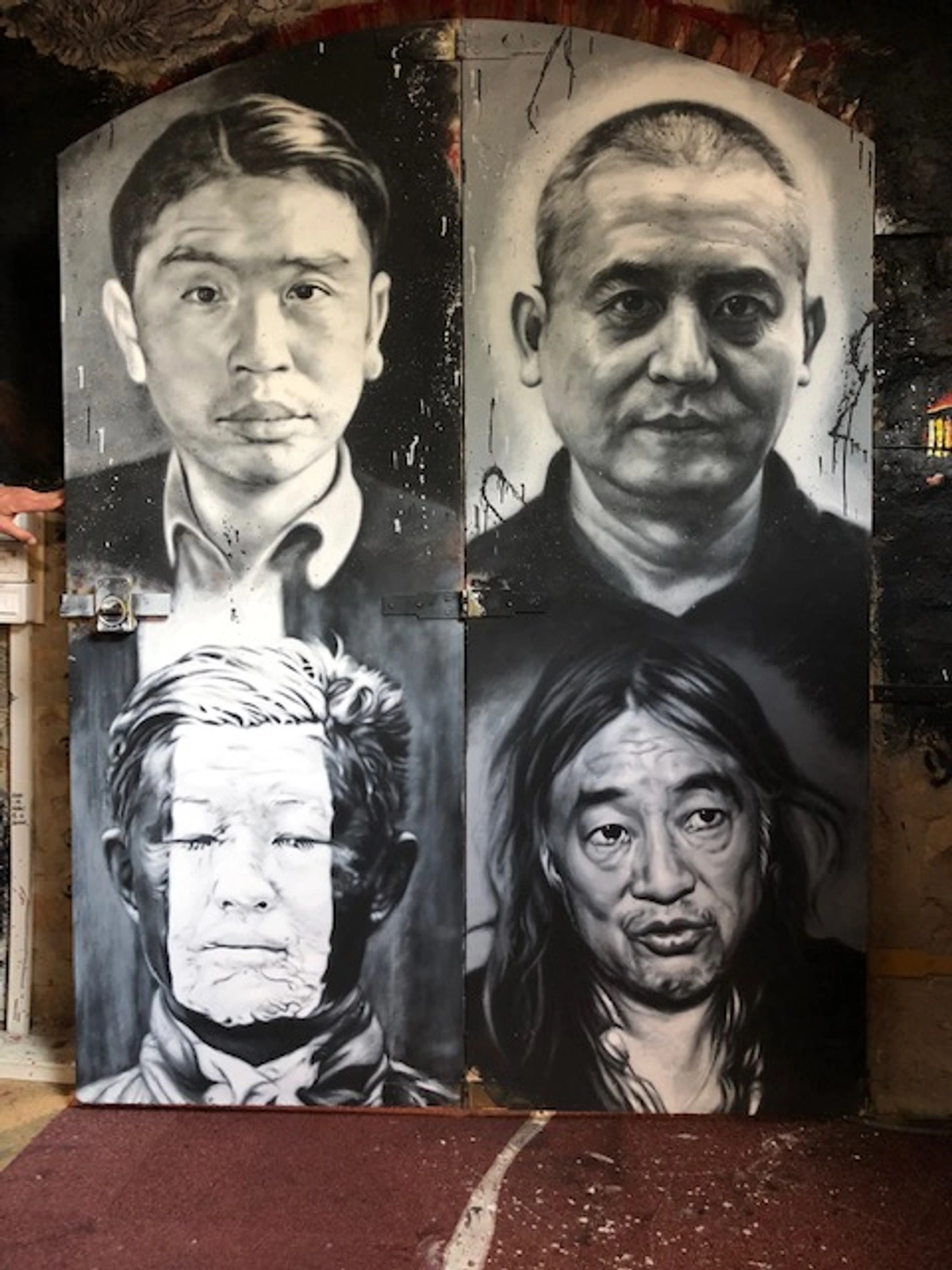
Key Periods and Iconic Works: More Than Just Masks
Zeng Fanzhi's career isn't monolithic; it's a dynamic journey through distinct phases, each reflecting different concerns and stylistic explorations. Understanding these shifts is key to appreciating his depth. So, let's peel back the layers and see how his artistic voice evolved:
Period | Key Characteristics | Dominant Feeling | Notable Work/Example |
|---|---|---|---|
| Early 1990s | Raw, expressive figures, medical themes | Unflinching, visceral, anxiety | Hospital Series |
| Mid-90s - Early 2000s | Stylized, masked faces, large hands, urban scenes; intimate portraits alongside | Alienation, conformity, hidden anxiety, introspection | Mask Series, The Last Supper, Portraits & Faces |
| Mid-2000s - Present | Abstract, tangled branches, energetic brushwork; exploration of new mediums | Overwhelming nature, chaos, meditative, continuous evolution | Abstract Landscapes / "We" Series, Sculpture, Multimedia |
1. The Hospital Series (Early 1990s)
Before the masks, there were the hospitals. Imagine the sterile air, the quiet hum of machinery, the raw vulnerability laid bare – that's where Zeng Fanzhi found his early inspiration. He spent time observing scenes in a local hospital, reportedly drawn to the raw, unfiltered emotions visible there – the pain, vulnerability, and detachment. The resulting paintings are… intense. What is it about scenes of raw vulnerability that pulls us in? I sometimes wonder if it's a primal recognition of our own fragile existence, or perhaps a secret longing to witness something so brutally honest in a world often demanding composure.
- Subject: Patients, doctors, operating rooms. Scenes of suffering, anxiety, and clinical detachment.
- Style: Raw, expressive brushwork, often fleshy pinks and reds contrasted with stark whites. Figures are distorted, capturing psychological states rather than literal likeness.
- Feeling: Unflinching, visceral, almost uncomfortably intimate. It feels like looking at a raw nerve exposed. Imagine a canvas dominated by stark white sheets and a lone, distorted figure, their face a swirl of raw, almost painful pinks and reds – it's the kind of art that makes you squirm a little, like you've accidentally walked into a private moment of vulnerability. This early work already showed his interest in human vulnerability and the anxieties lurking beneath the surface. It's almost as if he was channeling the raw emotional power we see in some of the great Modern Art movements, isn't it?
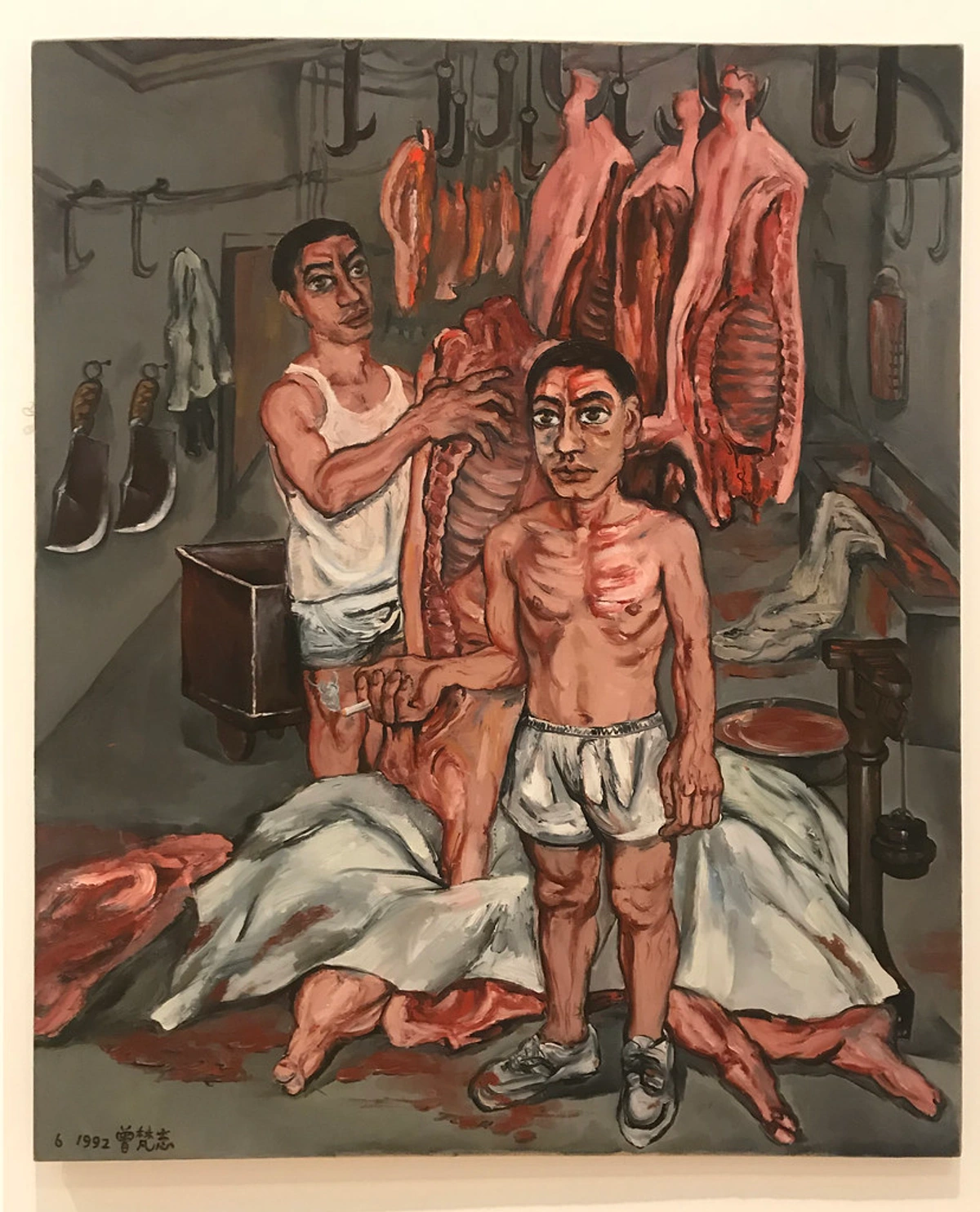
2. The Mask Series & Parallel Portraits (Mid-1990s - Early 2000s)
This is arguably his most famous body of work – the one that really put him on the international map. After moving to Beijing, a sprawling, rapidly changing metropolis, his focus shifted. I remember feeling a similar sort of disorienting pressure when I moved to a big city, that sense of needing to adopt a certain persona, a 'mask,' just to navigate the sheer density of it all. It felt like everyone had their polished exteriors, and I was just trying to figure out which smile fit my face. This period coincided with China's accelerated economic reforms, rapid urbanization, and a growing consumer culture, creating a fascinating tension between traditional collective identity and burgeoning individualism. The "masks" became a potent metaphor for social performance and the anxieties bubbling beneath the surface of a seemingly harmonious society.
- Subject: Urban dwellers, often in groups or alone, always wearing stylized, mask-like faces with fixed smiles. Their hands are often disproportionately large and ruddy. Alongside these, he created intense, unmasked portraits focusing on individual identity.
- Style: Smoother surfaces than the Hospital series, but still with expressive undercurrents. The masks themselves are unsettling – are they hiding true feelings or performing a social role? The parallel portraits offer a more direct, yet equally intense, gaze into the human condition.
- Feeling: A sense of alienation, conformity, and hidden anxiety beneath a veneer of politeness or success. It’s like he captured that feeling of being surrounded by people yet feeling utterly alone, a common modern condition. We all wear masks, don't we? Maybe not physical ones, but social ones, every single day. Zeng just made them literal, and hauntingly so. If you're searching for "zeng fanzhi paintings", chances are you'll encounter this series first.
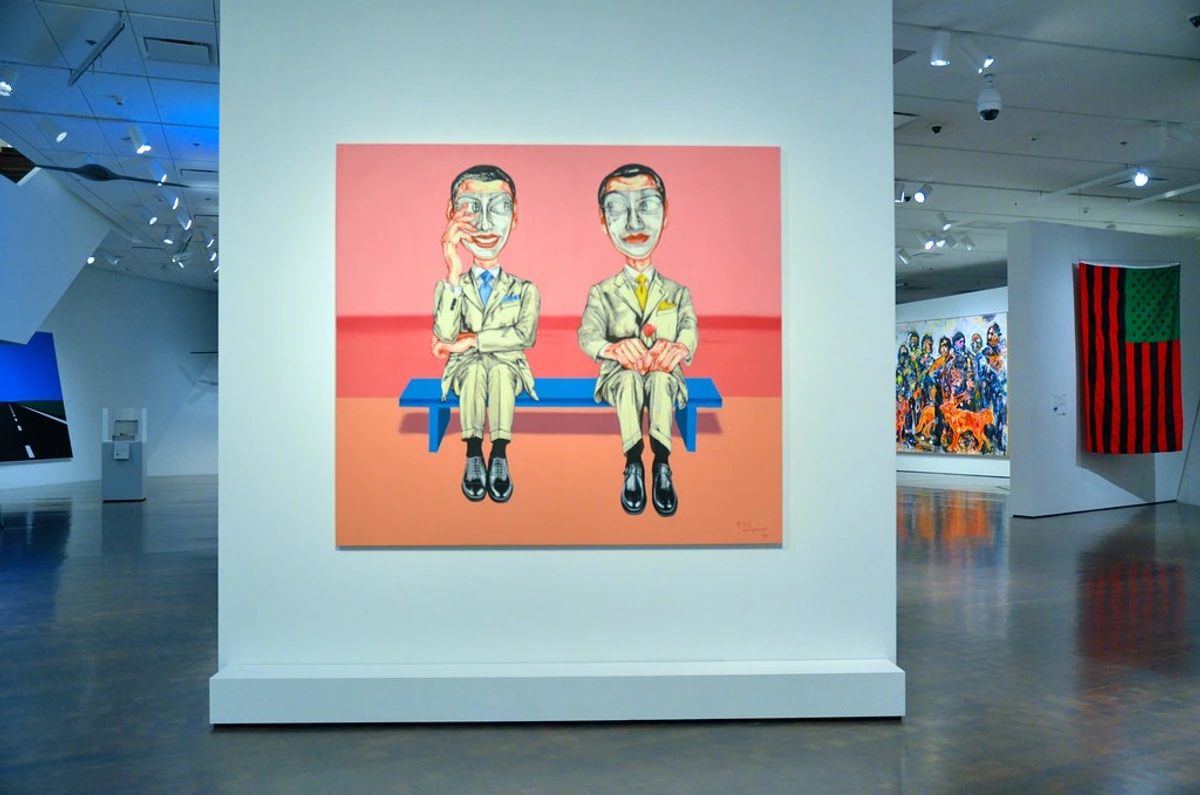
3. "The Last Supper" (2001) - A Mask Series Masterpiece
Within the Mask series, "The Last Supper" stands out, not least because it fetched a record-breaking price of over $23 million USD at auction, making it one of the most expensive works by a contemporary Asian artist. People searching for "the last supper zeng fanzhi" find a fascinating reinterpretation. Beyond the staggering price, critics often highlight its profound commentary on China's rapid embrace of capitalism and Western influences. Some found it a powerful, if uncomfortable, indictment of the societal shifts, while others questioned the extent of its critical bite given its commercial success.
- Composition: Based loosely on Leonardo da Vinci’s iconic work.
- Figures: Features 13 figures resembling Young Pioneers (from the Communist youth league), all wearing masks except for the 'Judas' figure, who wears a Western-style yellow tie.
- Symbolism: Rich with potential interpretations – commentary on China's rapid shift towards capitalism? A critique of conformity? Betrayal within a seemingly unified group? It's like he took a sacred Western image and jammed it into the chaotic, bewildering reality of post-Mao China, where everyone was suddenly chasing success, sometimes at the cost of authenticity. That solitary yellow tie on 'Judas'? A brutal, brilliant whisper about betrayal, maybe of ideals, maybe of community, as the market roared to life. Trying to decipher "The Last Supper" is like being handed a cryptic crossword puzzle at a party – you know there's a brilliant answer, but you're not quite sure where to start, and you're pretty sure you're missing a crucial clue. It’s a work that invites analysis, much like learning how to read a painting involves looking beyond the surface. Its market success also highlights factors that play into understanding art prices.
4. Abstract Landscapes / "We" Series (Mid-2000s onwards)
From the crowded, masked figures of urban life, Zeng Fanzhi plunged into the sprawling, untamed beauty of abstract landscapes. In a significant stylistic shift, he moved away from figurative representation towards these monumental works, often dominating the wall they inhabit, further enveloping the viewer in their intense energy. It's like he suddenly needed to breathe, to escape the social pressures of the masks and find a different kind of truth in nature's wild embrace.
- Subject: Dense, tangled branches, chaotic yet beautiful natural scenes. Often titled simply "Untitled" or part of the "We" series. Is it 'we' as in humanity, collectively navigating chaos? 'We' as in the tangled web of nature and human consciousness? He leaves it open, doesn't he? The beauty, for me, lies in that open invitation: to bring your own 'we' to the canvas, whether it's our collective humanity navigating shared chaos, or simply the tangled web of our individual consciousnesses, and for me, it often evokes that feeling of navigating the chaotic beauty of my own inner landscape, sometimes dense and tangled, sometimes surprisingly clear.
- Style: Highly textured, often created using vigorous, almost violent brushstrokes, sometimes painting with two hands simultaneously, or even sticks. Layers upon layers of paint create intricate, web-like surfaces. It's not just painting; it's almost a physical wrestling match with the canvas, a dance of chaos and control, reminiscent of the raw energy found in Abstract Expressionism or the fluid vitality of traditional Chinese calligraphy.
- Feeling: A sense of overwhelming nature, chaos, energy, but also a strange meditative quality. It’s like plunging into the wild, untamed parts of his own mind, or maybe just the world outside his window. It’s messy, beautiful, and utterly absorbing, like getting lost in a dense forest and finding clarity in the chaos. While his approach is distinctly modern, one can sometimes glimpse a subtle echo of traditional Chinese landscape painting's deep reverence for nature, albeit filtered through his intensely personal and often turbulent lens.
Homages to Masters: The Van Gogh Connection
This later landscape phase often draws comparisons to other masters, notably Vincent van Gogh. If you're searching for "zeng fanzhi van gogh", it's likely related to these works.
- Connection: It's not direct copying, but an homage to the energy and texture found in Van Gogh's work. Think of the swirling cypresses or turbulent skies in Van Gogh's paintings – Zeng captures a similar intensity and expressive use of paint in his tangled branches. It's a dialogue across time, explored through the medium itself. You can explore more about Van Gogh's unique style in this ultimate guide to Van Gogh.

5. Later Works & Evolving Mediums: Beyond the Canvas (Mid-2000s onwards)
True artistic vision rarely stays confined to a single medium. As Zeng Fanzhi continued to explore his abstract landscapes, his boundless energy and thematic depth propelled him into new territories, demonstrating a relentless pursuit of expression. It’s as if the canvas itself became too small for the ideas brimming within him.
- Sculpture: Venturing into sculpture allowed him to translate the psychological intensity and distortion of his painted figures into three dimensions. Often working with bronze, his sculptures frequently feature powerful, fragmented, or elongated forms that echo the unsettling hands and masked faces of his earlier works, adding a palpable weight and presence to his explorations of human identity and vulnerability. You can almost feel the emotional heft, the silent scream of an unspoken truth, trapped within the metal.
- Multimedia Installations: Perhaps the most expansive evolution, his multimedia installations integrate video, sound, and other elements to create immersive, contemplative experiences. These works invite viewers into a more holistic sensory engagement with his themes of chaos, nature, and the human psyche, demonstrating his willingness to push boundaries and explore new ways to connect with an audience. It’s a brave step, isn’t it? To take all those internal musings and project them onto a multi-sensory stage, inviting everyone to step inside your swirling thoughts.
His foray into these new mediums further cements his place as a versatile and continuously evolving artist, proving that an artist's journey is truly never over. The desire to capture the world, or indeed, the inner landscape, in new ways is a constant, almost gravitational pull. You can explore more about the history and practice of sculpture if this resonates with your own artistic curiosity.
Core Themes and Artistic Style
So, what really ties all these disparate periods together? For me, it's the feeling of wrestling with something profound, something deeply human, even when the visual language shifts. Across his different series, some consistent threads emerge:
- Identity and Alienation: Especially prominent in the Mask series, exploring the gap between inner self and outer presentation in modern society. Honestly, who hasn't felt a bit like they're wearing a "social mask" on a Monday morning, trying to seem far more put-together than they feel? Zeng just takes that everyday facade and makes it beautifully, hauntingly literal.
- Social and Political Commentary: Reflecting on China's rapid changes, the pressures of urbanization, and shifts in ideology, particularly evident in the critiques embedded within the Mask series and "The Last Supper." It's like he's holding up a mirror, asking us to consider the cost of progress.
- Globalization and Cultural Identity: A recurring tension between traditional Chinese values and the influx of Western culture and capitalism, often subtly woven into his figures and symbols. It makes you wonder how much of our own cultural heritage we inadvertently trade away for something new.
- Human Vulnerability: From the raw pain of the Hospital series to the hidden anxieties of the Mask series. There’s something universally unsettling, yet deeply relatable, in seeing our hidden discomforts laid bare. This particular theme, for me, often hits hardest; it’s the quiet whisper of shared human experience, the vulnerability beneath all our carefully constructed veneers.
- Nature and Chaos: Explored particularly in the later landscapes, finding beauty and complexity in seemingly disordered natural forms. It’s a reminder that even in the most tangled parts of the world, or ourselves, there's a strange, compelling order to be found.
- Evolution and Transformation: Zeng Fanzhi's career is defined by his continuous stylistic shifts and exploration of new mediums. This persistent evolution underscores his restless artistic spirit and unwavering commitment to pushing boundaries, always seeking new ways to articulate his vision.
- Expressive Technique: Whether distorted figures or tangled branches, his brushwork (and later, use of palette knives or even sticks) is always energetic and conveys emotion. Bold brushstrokes, impasto, and layering are key elements. It’s less about precise depiction and more about the visceral act of creation itself.
Zeng Fanzhi's Place in the Art World
Zeng Fanzhi is undoubtedly one of the most significant figures in Chinese contemporary art in China and a major player on the global stage. His work bridges Eastern and Western influences, reflecting a unique perspective shaped by his specific time and place. His works aren't just selling for millions; they're regularly exhibited in major institutions globally, from the Musée d'Art Moderne de la Ville de Paris to the Ullens Center for Contemporary Art in Beijing, and at prestigious galleries like Gagosian and Hauser & Wirth. Significant retrospectives, such as his solo show at the Musée d'Art Moderne de la Ville de Paris in 2013, further cemented his international reputation, providing comprehensive insights into his evolving practice. While it's perhaps too early to definitively gauge his full influence on future generations of Chinese artists, his stylistic courage and willingness to tackle profound societal shifts have certainly carved a path and set a high bar for contemporary practice.
His critical acclaim is matched by commercial success, with his works commanding high prices at auction. While market value isn't the only measure of importance, and frankly, the astronomical sums can sometimes feel a bit surreal – like a game of Monopoly played with real masterpieces, where the price tags seem to belong in a different dimension – it does reflect the significant impact his work has had and the high demand among collectors. Critics often highlight his ability to translate profound social anxieties into universally resonant visual narratives and praise his ongoing stylistic evolution. It's the kind of art you might see in major museums for modern art over the world, or perhaps even inspire someone to start their own art collection on a budget focusing on powerful contemporary pieces. It's clear his artistic journey is far from over.
Frequently Asked Questions (FAQ)
- Q: Why did Zeng Fanzhi paint masks?
- A: The Mask series reflects his feelings about moving to Beijing in the 1990s. He felt people were hiding their true selves behind polite facades or "masks" in the rapidly changing, conformist urban environment. The masks symbolize social pressure, hidden anxiety, and the performance of identity.
- Q: What is Zeng Fanzhi's most famous painting?
- A: While the Mask series is his most iconic body of work, "The Last Supper" (2001) gained significant fame due to its record-breaking auction price (over $23 million USD) and its provocative reinterpretation of a classic Western image through a contemporary Chinese lens.
- Q: How is Zeng Fanzhi related to Van Gogh?
- A: Zeng Fanzhi's later abstract landscape paintings share an energetic, textured quality reminiscent of Van Gogh's expressive brushwork, particularly in depicting nature (like tangled branches). It's generally seen as an homage or dialogue with Van Gogh's style and intensity, rather than a direct imitation. You can explore more about Van Gogh's unique style in this ultimate guide to Van Gogh.
- Q: Is Zeng Fanzhi's work hard to understand?
- A: Like much modern art, it can be challenging initially. His work is layered with personal experience, social commentary, and art historical references. However, focusing on the emotional impact, the visual techniques (like the masks or the chaotic lines), and the context of his life in transforming China can provide entry points. Learning how to read a painting can help unlock deeper meanings.
- Q: Where can I see Zeng Fanzhi's work?
- A: Zeng Fanzhi's works are regularly exhibited in major museums and galleries worldwide, including the Musée d'Art Moderne de la Ville de Paris, the Ullens Center for Contemporary Art in Beijing, and prestigious galleries like Gagosian and Hauser & Wirth. His pieces are also held in numerous prominent private and public collections globally.
- Q: Has Zeng Fanzhi's style continued to evolve recently?
- A: Yes, Zeng Fanzhi continues to explore new artistic directions. While still engaging with abstract landscapes and occasional portraits, he has also ventured into sculpture and explored multimedia installations, further pushing the boundaries of his artistic expression and reflecting his ongoing engagement with complex themes.
Final Thoughts: Beyond the Surface
Zeng Fanzhi's art isn't always easy, but it's undeniably powerful. It captures the complexities of a specific time and place – modern China – yet speaks to universal themes of identity, anxiety, and our relationship with the world around us. Whether it's the haunting gaze from behind a mask, the chaotic energy of a tangled landscape, or the silent presence of a bronze figure, his work invites you to look closer, to question, and to feel. It’s a reminder that sometimes the most compelling art comes from confronting the uncomfortable truths, both personal and societal. And perhaps, in grappling with the questions Zeng Fanzhi's art poses, we find ourselves a little more attuned to the masks we wear, the landscapes within us, and the unsettling beauty of simply being human. It's a journey, isn't it? One that starts on a canvas but ends somewhere deep inside ourselves. If his journey inspires your own contemplative or creative endeavors, perhaps you'll even be moved to explore new artistic expressions, or find a piece that speaks to your own inner landscape, like the ones you might discover on our art for sale page, or a visit to our own museum.


